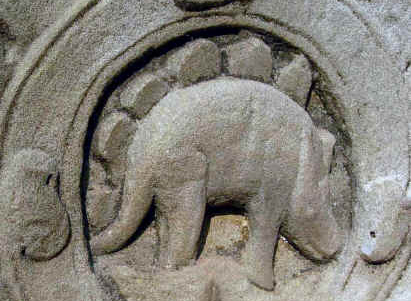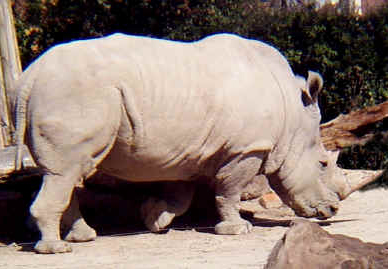|
Its Tail
In proportion to its body size, the tail of the creature above appears larger than that of
the rhinoceros. Its base is about 1/2 the diameter of its hind legs, and
only slightly smaller than its front legs. Its tail droops
down and away from its body, and appears to touch the
ground. Note also that the end of its tail is horizontal
to the ground -- and that it appears to go beyond the
drawing: meaning that its end is not depicted. This explains why there are no spikes
on it.
Its Back
has plates
The creature above appears to have large structures or plates all across the top of
its back. Its back also is rounded like a
ball.
Its Horn is
missing
The creature above does not appear to have a horn on its snout.
Its Eye
The eye of the creature above is near the middle of its head
Its Ears
(or Frill)
The creature
above has either long pointed ears, or a frill (or shield) around the
top of its head (?)
Its Hind
Leg
The creature above has a hind leg-joint that is straight
|
Its Tail
Note that the
rhinoceros' tail is quite small -- only about 1/4th -- 1/10th the size
of its hind leg. Note that it droops straight down toward
the ground, and that it does not reach the ground, but
appears to be about 18-24 inches above it. In fact, the end
of its tail is slightly higher from the ground than its belly.
Note also that its tail is perpendicular to the ground. Its
Back has no plates
The rhinoceros in the picture above does not appear to
have any structures or plates on its back. The rhino's back is
mostly straight -- and/or horizontal to the ground. Its
Horn
The rhino has a large horn that protrudes out
from the top of its snout. Its
Eye
The eye of the rhino is near the top of its head. It
Ears
The rhino has no frill or shield around its head, and its ears are
only slightly pointed Its
Hind Leg
The rhino's hind leg-joint points backward
|

